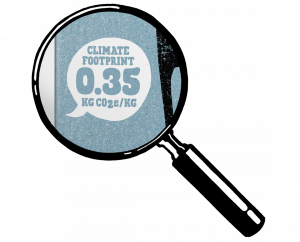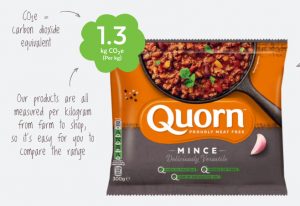
Image courtesy Oatly
Move over, nutrition facts – food companies and consumer packaged goods manufacturers are adding carbon-footprint labels to their products in an effort to be transparent about their environmental impact.
Now hemp and marijuana companies are considering whether to jump on a trend experts say will intensify as governments double down on climate goals.
President Biden pledged last week to cut U.S. greenhouse gas pollution in half by 2030.
“These steps will set America on a path of a net-zero emissions economy by no later than 2050,” said Biden, who has ambitious goals to address climate change through efforts such as de-carbonizing the U.S. power sector by 2035 and developing a carbon bank that would pay farmers to adopt regenerative practices.
Businesses respond
Pressure for corporate transparency on carbon is mounting from consumers, said Ethan Soloviev, chief innovation officer for research firm HowGood.
And with more companies taking part, that pressure to comply will only increase.
He points to New York University’s 2020 Sustainable Market Share Index, which found that sustainability-marketed products are responsible for more than half of the growth in consumer packaged goods from 2015 to 2019, and that the growth continued despite the COVID-19 pandemic.

Image courtesy Oatly
“Those products that are more sustainable are selling way better than their category, across many major consumer goods,” Soloviev told Hemp Industry Daily.
Brands of all sizes, from plant-based milk brand Oatly to Unilever with its 70,000 products, have responded by adopting consumer-facing labels showing the amount of carbon released during a product’s lifecycle.
“It’s huge this year and I expect to see a lot more of this in the years to come,” said Soloviev, whose company has built a sustainability database and impact platform to help brands, retailers and investors improve their environmental and social impact, including restaurant chain Chipotle.
Some say cannabis companies will be next.
“We are an industry that has needed to have the ability to continually adapt, and effectively adapt, really since it started,” said Ryan Cross, operations manager at River Organics, which grows hemp and makes CBD products in Gloucester, Virginia. “So if consumers are demanding environmentally cautious production methods and transparent labeling, they really should get it.”
He said labels would be especially welcome in an industry as young as cannabis.
“All of our products for a long time could only be accessed illegally. So anytime we can provide our consumers with knowledge and transparency, I think it’s a benefit in the long term.”
What’s in a label?
But the process to get to accurate carbon labels could be an enormous challenge for cannabis, where market standards are new and developing.
Carbon labeling isn’t as simple as setting out nutrition facts, said Jeff Friedland, CEO of Golden State Hemp, a producer in Fresno, California, that has hired carbon specialists to work on carbon labels.

Image courtesy Quorn
“There’s a whole slew of things that you have to really think about that go into that, so everything from fertilizers to harvesting and transportation – all of those factors have to go into a formula to determine are you negative or positive in carbon emissions,” Friedland said.
Annie Rouse, chief operating officer of hemp formulations company OP Innovates in Lexington, Kentucky, pointed out that cannabis crops would need to be produced sustainably from the start. Simply using a common synthetic fertilizer can emit nitrous oxide, worse for the environment than carbon.
“It’s really hard to be carbon-negative or carbon-neutral – you’ve got to think about everything that goes into that little product,” Rouse said.
And there is little guidance for auditing or updating carbon labels. That could make it challenging to ensure consumer trust in the labels.
“All advertising statements must be truthful and not misleading,” said Asa Waldstein, founder of the Supplement Advisory Group in Boulder, Colorado.
“Deceptive marketing practices are not only ‘bad vibes’ and irritate customers, but it can also lead to an expensive class-action lawsuit.”
Carbon-labeling efforts underway
A coalition of farmers, engineers and other agriculture professionals are working on answering questions surrounding what goes into carbon labeling, said Derek Smith, executive director of the Resource Innovation Institute (RII).
The Oregon-based nonprofit has built benchmarking platforms for companies to measure their water use and waste production.
Now RII is expanding into cannabis and other floriculture crops to establish key performance indicators, standards and ultimately a verification and leadership recognition system for crops produced in controlled environments.
The nonprofit is building a common data set that will help producers compare their operations and move toward a more efficient production model, Smith said.
Part of this includes developing an overall facility or farm performance score.
“Our position has always been that we cannot create a label that we can stand behind as verifying performance until we have enough data set that can inform what is good performance,” Smith said.
Ultimately, RII will develop a badge that compliant companies can place on their products, Smith said.
“As that data set grows, we’ll be able to verify performance and feel confident that the badge we enable leaders to be identified with is substantiated and will truly result in carbon emission reductions.”
RII hopes to have the system ready by 2022.
Moving forward
Soloview said the process can be daunting for new companies, but that even getting started can build value.
“Even if you start the path and don’t finish … the amount that you learn along the way will be awesome, and you can tell the story of your journey towards putting a carbon label on,” Soloviev said. “Even that would be a first in the market.”
Cannabis companies investing now in efforts to be greener and educating consumers about their products could pay off later, Waldstein said.
“Hemp and marijuana companies had a tough year of reflection and feel-good marketing campaigns that support the earth and excite customers help differentiate a brand,” he said.
“Now is the time to build a strong customer following because when FDA cannabinoid regulation comes, massive companies waiting at the starting gate will swoop in and try to gain market share. Developing and keeping a customer base of brand fanatics can mean the difference between long-term success and failure.”
Laura Drotleff can be reached at [email protected]

